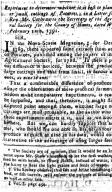[ Whether to Plant Large or Small Potato Cuttings ]
Date: 1791/04/30
Source:
Weekly Chronicle
Institution: Nova Scotia Archives
| Source Origin: Nova Scotia Newspapers on Microfilm
_____
Experiment to determine whether it is best to plant large
or small cuttings of potatoes; in a Letter from the
Rev. Mr. Cochran to the Secretary of the Agricultu-
ral Society for the County of Hants, dated Windsor,
February 12th, 1791.
SIR,
IN the Nova-Scotia Magazine, I for December
1789, there appeared some extracts from an Essay
on Potatoes, published among the papers of the Bath
Agricultural Society, for 1788. In these a prodigi-
ous difference is noticed, between the produce from
large cuttings and that from small, in favour of large
ones, as nine to one.
That a considerable difference of produce might
escape the observation of mere practical farmers, who
seldom make comparative experiments, is readily to
be supposed, and that, therefore, it might still be a
disputed point amongst them, whether large or small
cuttings are most profitable, as the author who relates
those experiments asserts it is, and as we know it to
be here. But we can hardly suppose that any far-
mer, who should see one acre in his neighbour’s field
produce as much as nine in his own, would continue
inattentive to the advantage of using larger seed.
___________________________________________
* The Society are of opinion, that it would be an improve-
ment upon Mr. Shaw’s method, to let the first washing of the
seed be with brine, or a strong pickle, instead of water, in order
the better to float the light grains and seeds of weeds.
† The Society observe, that salt and brine remaining in port,
Beef, or fish barrels, will answer the purpose of brining wheat,
As well as other [salt].
I Vol. 1. Page 454.
In the extracts, where this amazing disproportion
of produce is mentioned, it is not stated what pro-
portion the cuttings, used in the one and in the o-
ther case, bore to each other. Probably there was
a greater difference than between those which are
commonly used here. However if the loss by plant-
ing small cuttings should only be one half, or even
one fourth part of that mentioned above, still it
would be an object highly deserving the attention
of farmers. I thought, therefore, it might not be a
useless experiment, to try two or three different sizes
of cuttings, near to those usually planted in this
neighbourhood, and to mark the difference of pro-
duce, if any.
For this purpose, in the second week of June last,
I took an equal number of cuttings, of three differ-
ent sizes; the largest (No. 1.) were somewhat larger
than those usually planted here. The second size,
which I shall call No. 2. was less than one half of
No. 1. The third size (No. 3.) was about one
third of No. 2.*
I planted 100 hills with each size, four cuttings in
each hill. The land, manure, and cultivation as
nearly alike as I could make them.
From the first appearance of the plants a striking
different, in favour of the largest size, was observable.
Many of the hills from No. 1. had ten, twelve, or
fourteen stalks, strong and healthy. Those from
No. 2. much fewer and weaker. Those from
No. 3. in many instances had not more than four
stalks, and those small and feeble. The difference,
though still very perceptible, was not so great towards
the end of the summer, as at the beginning.
In the beginning of November they were all taken
up and the produce weighed
No. 1. Produced 280lbs.
No. 2. 2491/2
No. 3. 168
The medium weight of a bushel, upon several
trials, was found to be 61lb. Therefore the produce
of No. 1 was something above four bushels and a
half; and the difference between No. 1. and No. 3.
nearly two bushels. This is very considerable. If
an acre, planted with cuttings such as No. 1. would
produce 200 bushels by planting such as No. 3. the
farmer will lose 80 bushels. In four acres the loss
will be 320 bushels; in eight acres, which many far-
mers plant in a season, it will be 640 bushels!
I am informed, that some farmers in the province
plant only the eyes of their potatoes, and give the rest
to their cattle or hogs. With these the loss must be
still greater.
I design to pursue the subject farther, and may
hereafter communicate the result to the Society.
Meanwhile, with the greatest respect for you and
them
I remain, Sir,
Your most obedient,
And most humble servant.
WILLIAM COCHRAN
(To be continued.)
* The cuttings of each size were weighed, and the weight
noted at the time of planting, but the memorandum has been
mislaid. However, although I cannot recollect the absolute
weight, I am certain the proportion to each other was, very
nearly, as above.
Download: Transcription | Images

